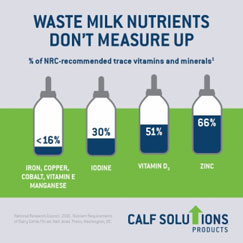
Imagine if waste milk came with a product label that listed nutrient values and fat, protein and lactose concentrations. You’d know exactly what calves take in each day without testing equipment. A majority of waste milk doesn’t contain all the essential nutrients calves need. But, without a nutrition label or sophisticated testing equipment, it’s hard to tell if you’re giving calves what they need. And, what happens when nutrient levels aren’t up to par?
“Fortifying the liquid ration with a vitamin and trace mineral pack, at a minimum, helps ensure that calves receive a balanced, consistent ration of essential nutrients each day to support healthy development,” says Skip Olson, technical services veterinarian for Milk Products.
Waste milk’s nutrient values can change daily, often falling short of nutritional requirements to support calf health and development. Here’s a look at how fortifiers can put your calves on a path to success.
Where waste milk hits (and misses) the mark
Waste milk typically provides an adequate supply of B-complex vitamins and vitamin A to calves. When it comes to macrominerals that are essential for calf development, however, waste milk falls short. In fact, waste milk does not meet National Research Council recommendations for iron, manganese, zinc, copper iodine, cobalt, vitamin D, vitamin E and selenium in pre-weaned calf diets.[1]
These vitamins and minerals are essential for calf growth, immunity, synthesis of hormones that regulate energy metabolism, bone formation and maintenance of cellular membranes. Thanks to waste milk supplementation, dairy farmers have made progress in addressing selenium deficiencies, but associated problems like calf weakness continue to appear.[2]
“Waste milk selenium levels are highly variable depending on where your farm is located,” says Olson. “Thin cows fed inadequate nutrition are more likely to produce milk with low selenium levels. Some regions have selenium-deficient soils, resulting in deficient feedstuffs, too. When passed on to calves, selenium deficiency can result in weakness, injury and white muscle disease.”
Macronutrient variability in waste milk can make calf nutrient intake a guessing game. Fortifying waste milk provides a balanced, consistent ration of selenium and other trace minerals every day.
The link between waste milk and starter intake
Waste milk variability can slow starter intake. How? Nutrient variation, and higher fat content in particular, can deter dry starter intake. Fat, protein and lactose concentrations of pasteurized waste milk vary from 22.3 to 37.6, 23.1 to 40.8, and 30.2 to 38.4%, respectively, research shows. [3]
“Farms using a complete waste milk diet are often unhappy with starter intake,” Olson says. “Problems with starter intake can compound vitamin and trace mineral variability. A fortifier can be the simplest and most efficient way to deliver a balanced ration consistently.”
Waste milk should be also be monitored and adjusted based on variable fat, protein and lactose content to help ensure a consistent nutrient ration that supports starter intake. Time and labor constraints on dairy farmers and access to on-farm analytical tools often make this impractical.
Adding a fortifier to ensure consistent nutrient body stores helps support the calf’s immune system during periods of illness and lower feed intake. And, a healthier immune system improves wellness and starter intake which stimulates growth of the rumen papillae and increases the rumen surface area to absorb nutrients – calves can potentially be weaned earlier.[4]
Promoting calf half, delivering medicine
Calves aren’t born with complete natural immune defenses. They’re built over time with the help of vitamin and trace minerals. However, waste milk has highly variable levels of vitamins and trace minerals. It changes based on a cow’s late gestation feed intake and feed and forage quality. Resulting deficiencies in calves can contribute to reduced disease resistance and increased probability of morbidity and mortality.[5]
“Aside from providing vitamin A and other key nutrients and trace minerals to build calf immune defenses, fortifiers can also deliver a host of additional beneficial agents to calves through their milk ration,” says Olson. “Examples include coccidiostats, ionophores, larvicides, yeast-derived supplements and essential oils.”
Coccidiostat support calf intestinal health by acting on coccidia parasites, ionophores enhance cattle efficiency by altering ruminal fermentation patterns, and larvicides provide feed-through fly control, helping to prevent associated diseases in calves. So, in addition to supporting immune defenses, fortifiers can go a step further in ensuring healthy, efficient calf development.
Easily deliver a cost-effective, ideal nutrient package to your calves. Explore fortifier options at CalfSolutions.com.

Milk Products, based in Chilton, Wis., manufacturers high-quality animal milk replacers and young animal health products. Using its innovative manufacturing technology, Milk Products produces over 700 unique animal nutrition products for numerous independent feed manufacturers, wholesale distributors, and large retail chains. Our customers choose whether these products are sold under their private label brand, or under the Sav-A-Caf® brand which is manufactured and marketed by Milk Products.
Sources:
[1] http://www.dairyweb.ca/Resources/USWebDocs/CalfGrowth.pdf
[2] https://www.producer.com/2019/01/mineral-vitamin-deficiencies-can-delay-calf-development/
[3] https://onlinelibrary.wiley.com/doi/full/10.1111/j.1365-2672.2005.02569.x
[4] https://extension.psu.edu/rumen-development-dont-wean-calves-without-it
[5] https://www.producer.com/2019/01/mineral-vitamin-deficiencies-can-delay-calf-development/


